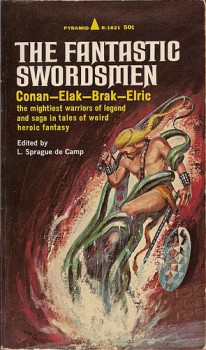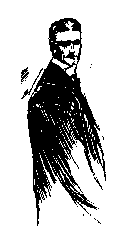Swords and Sorcery at its Pinnacle: A Look Back at The Fantastic Swordsmen

For those who put entertainment first, heroic fantasy offers it in its purest form.
— L. Sprague de Camp, The Fantastic Swordsmen
Although many of its foundational writers had already sailed into the west, swords and sorcery reached a Weird peak in the 1960s. In 1961 Fritz Leiber coined the term “swords and sorcery” in the journal Ancalagon. The Swordsmen and Sorcerer’s Guild of America (can I get a membership, please?) began the first of its secretive meetings. And the Lancer published, L. Sprague De Camp and Lin Carter-edited Conan series with its splendid Frank Frazetta covers was everywhere. These were heady times for the genre. Although the mass-produced works of the era can still be readily found and enjoyed today, I can only imagine when books like The Swords of Lankhmar could be found in drugstore wire spinner racks and the like.
In that strange time of tie-dye and Tolkien, when shining kingdoms lay spread across the pages of paperback books, Pyramid Books published four swords and sorcery anthologies. Edited by fantasy/science fiction author L. Sprague de Camp, the series began with Swords and Sorcery (1963) and concluded with 1970’s Warlocks and Warriors.
 “There was a man, Magnus’s son,
“There was a man, Magnus’s son,
 William Hope Hodgson’s Carnacki outlived his creator with a tenacity that Hodgson, a bantam rooster of a man, would have appreciated. Thomas Carnacki, resident of 472 Cheyne Walk, London, first appeared in a series of five stories (“Gateway of the Monster”, “The House Among the Laurels”, “The Whistling Room”, “The Horse of the Invisible”, and “The Searcher of the End House”) in The Idler Magazine in the January through April, as well as June, issues of 1910. But despite Hodgson’s death in World War I, Carnacki carried on in a further four stories (“The Thing Invisible”, “The Hog”, “The Haunted Jarvee” and “The Find”) retrieved from Hodgson’s papers by his wife.
William Hope Hodgson’s Carnacki outlived his creator with a tenacity that Hodgson, a bantam rooster of a man, would have appreciated. Thomas Carnacki, resident of 472 Cheyne Walk, London, first appeared in a series of five stories (“Gateway of the Monster”, “The House Among the Laurels”, “The Whistling Room”, “The Horse of the Invisible”, and “The Searcher of the End House”) in The Idler Magazine in the January through April, as well as June, issues of 1910. But despite Hodgson’s death in World War I, Carnacki carried on in a further four stories (“The Thing Invisible”, “The Hog”, “The Haunted Jarvee” and “The Find”) retrieved from Hodgson’s papers by his wife.